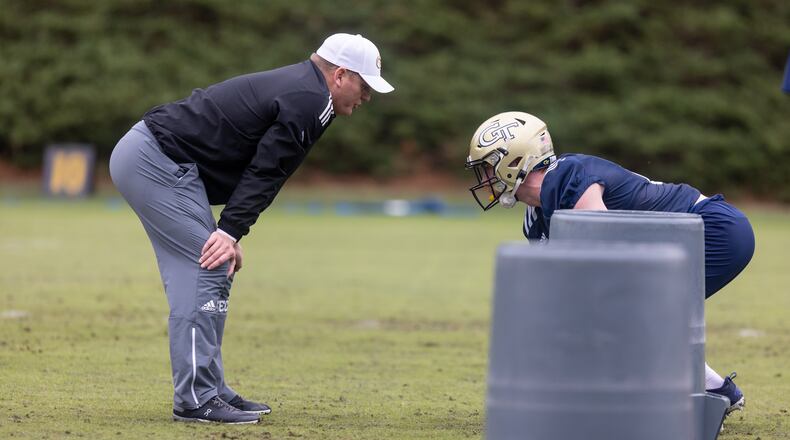Georgia Tech tight end Luke Benson knows the routine. Having played in an up-tempo offense at Syracuse before transferring to Tech, he learned the habits to enable the offense to move at a fast pace from play to play.
“If you’ve ever been in a tempo offense, you learn how to look to the sideline (for the next play call) when you’re running back to the ball,” he said. “Or if you see a guy that’s running towards you with his back to the signaler, you can tell him whatever the play is.”
Anything to get the offense set and ready to run the next play as soon as possible. It is a hallmark of the scheme that offensive coordinator Chip Long plans to implement for the Yellow Jackets in his first season with the team.
“The more we rep it, the better we get at it, the faster we get,” tight end Dylan Leonard said. “(Long) harps on that a lot, though.”
As Tech seeks every advantage it can obtain on offense after finishing last season tied for 92nd nationally in FBS in total offense and 100th in third-down efficiency – performance that led to the dismissal of offensive coordinator Dave Patenaude – pace of play is a primary lever that Long likes to pull. Going at a fast pace puts pressure on the defense to react quickly and also can stress its players’ conditioning.
When Long was offensive coordinator at Notre Dame from 2017-19, the pace helped the Fighting Irish finish 12th, 28th and 25th in FBS in Football Outsider’s efficiency index.
In addition to practicing at that pace to develop conditioning, Long is teaching the habits that Benson already has absorbed. Another is, after a play is blown dead, the ballcarrier needs to take the ball to an official rather than leave it on the ground, as handing it to the official speeds the process of getting the ball set for the next play.
“He’s definitely a high-paced offense kind of guy,” Leonard said. “He likes things to happen quickly. We’ve been adjusting our game to that, trying to get to our spots as quickly as possible – get our head around so (quarterback) Jeff (Sims) can see us.”
Speed was one facet of the offense that Long and the tight ends addressed in their media availability Thursday. Long mentioned another, his emphasis on the run game.
“If we can’t run, we’re going to be hurting,” Long said. “But that’s the mentality we like to have. With our ability to play a little bit of tempo, and with our (run-pass option), it kind of balances out pretty good. But you always want to try to be 60/40 run/pass.”
The ratio is not a requirement, but a guideline. Often, as Long noted, how a defense aligns or what aspect of the offense is effective can alter the balance.
“But obviously, you want to be a run-first team,” he said. “I just believe that helps you win in the fourth quarter and helps you close out games.”
In three seasons at Notre Dame, the run ratio was 61% in 2017, 56% in 2018 and 53% in 2019. The decline reflects, at least to some degree, Fighting Irish quarterback Ian Book taking control of the offense and Long’s reliance on him as an efficient passer.
While run-pass ratio is an indicator of an offense’s identity, it hardly dictates its success. In Tech’s three seasons with Patenaude, the Jackets’ run rate was similar – 62% in 2019, 59% in 2020 and 56% in 2021.
Given that Tech’s strength figures to be in its running back group, it hardly would be a surprise for Long to present a run-heavy scheme to Clemson when the Jackets open their season Sept. 5 at Mercedes-Benz Stadium (8 p.m., ESPN). Even after the transfer of All-American back Jahmyr Gibbs to Alabama, returnee Dontae Smith and transfers Hassan Hall (Louisville) and Dylan McDuffie (Buffalo) form a trio with experience and a history of production.
Long has expressed his prioritization on the run in another way. Often in practice, the offense splits up for a period in which the quarterbacks, receivers and tight ends compete against the secondary in one-on-one or two-on-two passing drills. At the same time, the running backs and offensive line drill against the defensive line and linebackers on run plays. Long said he doesn’t ever watch the passing drill.
“I go down and be with the big fellas for the inside run,” he said. “I think it’s important that their coordinator’s down there so they know the importance of that physicality and how much we believe in running the ball.”
About the Author
Keep Reading
The Latest
Featured


